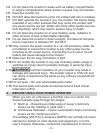
• 2 •
Do not place the inverter in areas such as battery compartments 1.4
or engine compartments where fumes or gases may accumulate.
Keep the inverter dry.1.5
DO NOT allow the inverter to come into contact with rain or moisture.1.6
DO NOT operate the inverter if you, the inverter, the device being 1.7
operated or any other surfaces that may come into contact with
any power source are wet. Water and many other liquids can con-
duct electricity, which may lead to serious injury or death.
Do not place the inverter on or near heating vents, radiators or 1.8
other sources of heat or ammable materials.
Do not place the inverter in direct sunlight. The ideal air tempera-1.9
ture for operation is between 50° and 80°F.
Only connect the power inverter to a 12-volt accessory outlet. Do 1.10
not attempt to connect the inverter to any other power source,
including an AC power source. Connecting to a 6-volt or 16-volt
battery will cause damage to the inverter.
Make sure the AC plug connection is tight.1.11
Do not modify the inverter in any way including cables, plugs or 1.12
switches as it may result in property damage or personal injury.
1.13 Incorrect operation of your inverter may result in
damage and personal injury. The inverter output is 120V AC and
can shock or electrocute the same as any ordinary household AC
wall outlet.
Do not open – No user serviceable parts inside.1.14
This device does not include an internal Ground Fault Circuit 1.15
Interrupter (GFCI).
BEFORE USING YOUR POWER INVERTER2.
When you turn on a device or a tool that runs on a motor, the
device basically goes through two stages:
Start Up – Requiring an initial surge of power (commonly 1.
known as the “starting or peak load”).
Continuous Operation – Power consumption drops (commonly 2.
known as the “continuous load”).
The wattage (WATTS) or amperes (AMPS) can normally be found
stamped or printed on most devices and equipment, or in the
user’s manual. Otherwise, contact the manufacturer to nd out


















